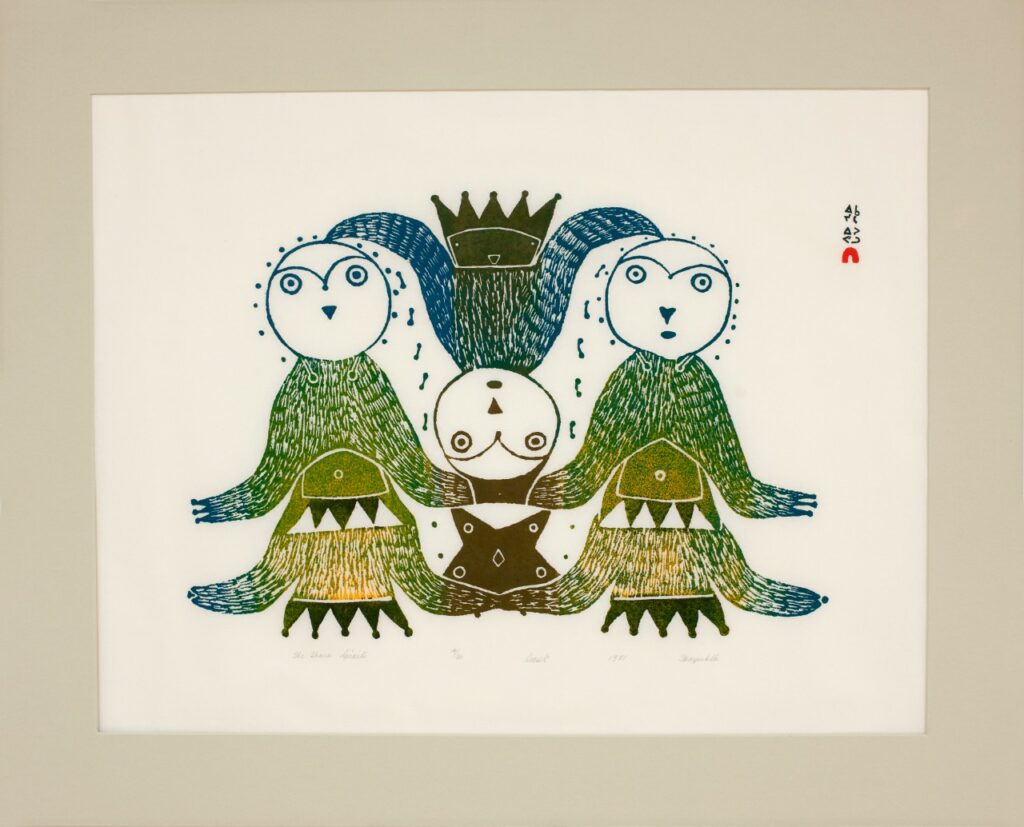
Stumbled across this 1966 stonecut print by Inuit artist Pitseolak Ashoona and fell in love. (Photo by Reese Muntean.)
The online home of Adventure Cartoonist Lucy Bellwood

Stumbled across this 1966 stonecut print by Inuit artist Pitseolak Ashoona and fell in love. (Photo by Reese Muntean.)
I’m wrestling with the letter I want to write to introduce my 2020 100 Day Project when I release it later this month. I’m feeling the pressure to get it just right. To say it just so. (Sound familiar? I keep finding different elements of this project to obsess over as a way to avoid sharing it. Go figure. Just share it, Lucy.)
I poked my head into Instagram briefly this morning and found Anis sharing a project that has its roots in a much older project and is now reemerging:
Back in 2014/2015 I was in a place of heavy loss, a place of relearning, rewiring, reforming my self, & began writing down & sharing online these monthly wisdoms/lessons for my self to learn, think on, & try to remember. Have wanted to return to this for years now, & being now in some months of heavy reflection seemed a good time for this returning. Here’s things I put down last month for me to hold & turn over & try to remember.
Here’s one:
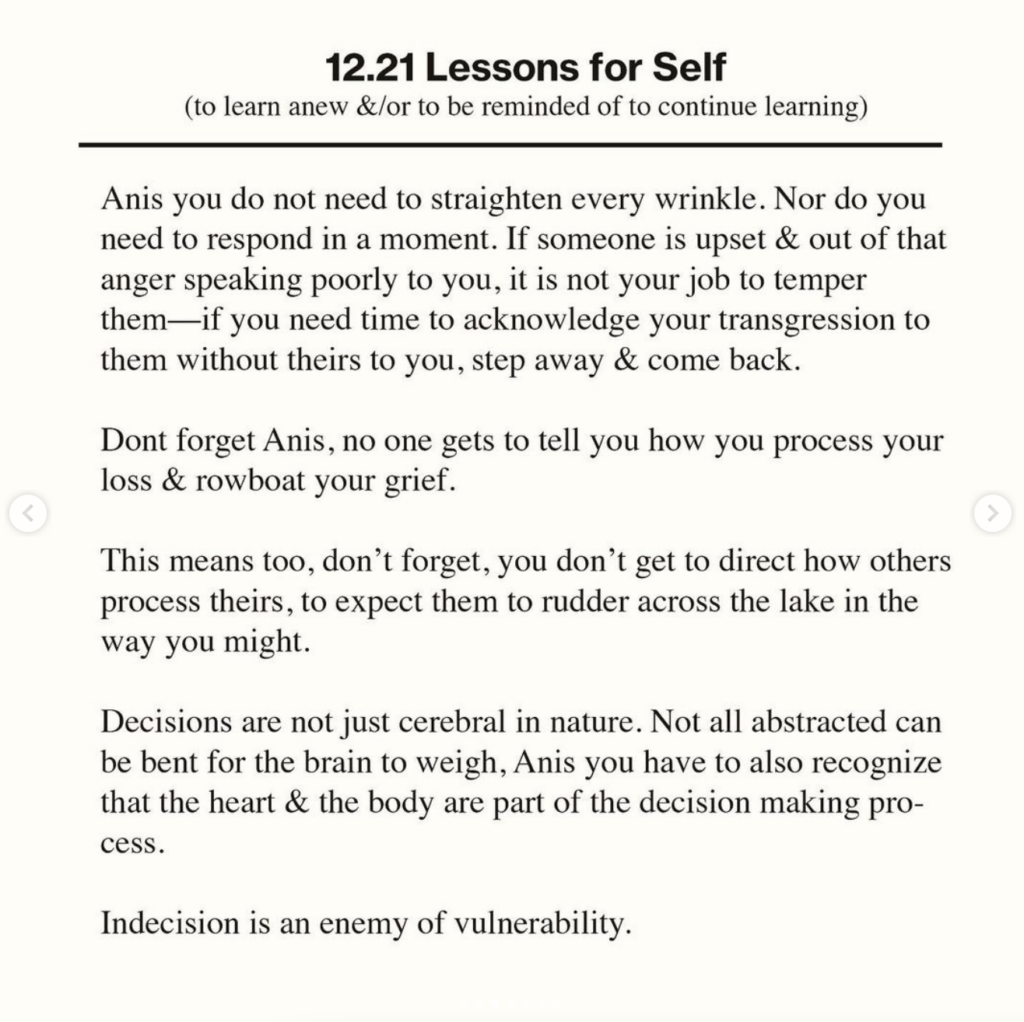
This subtitle sings to me.
It’s a funny thing how we all begin turning toward the same subjects at the same times (or have already been turning for several years). Reminders. Permission. Speaking to the self as the self, but at a removal from the self. This is the energy of the thing I’m about to release, too. Seeing it reflected in these words from my brilliant friend fills me with compassion and energy and, okay, a little envy, too. I have to elbow myself in the psychic ribs as if to say “Hey. Cut it out. There’s no race here, ya dingbat.”
On another slide, Anis writes:
I sometimes use vulnerability w/self to avoid vulnerability w/others. I wear my heart, but wearing can be a costume.
This is one of the things that drives me away from sharing such a personal thing in public. I want it to be known (I want to be known), but not in a space where I’ve traditionally used perceived vulnerability to mask real connection.
The greatest pleasure I’ve gotten from this project has been pressing the physical prototype (or the Dropbox folder of images) into the hands of trusted friends, and then talking about it with them. That’s energy I want to preserve moving forward. This connection. This depth.
I keep remembering Dad’s wedding reception
when Grandpa lost the word lily.
My hand out pointing to one of the centrepieces,
white flowers spilling over onto the table like wine.I had the garden in my head
when I asked him to name them.
The garden out behind the bungalow he built
that he always kept so neat. I saw him on his knees
in blue overalls, pruning. I saw him pretending
not to mind as a football went crashing
through the fuchsias. Then I saw his eyes,
panicked and dark as the hole where a word should be,
some kind of —and my dad said lily and this is how we manage.
—Joshua Judson (2020), via today’s installment of Pome.
Dad keeps the word lily. I keep the sunlight and the grey squirrels
cascading across the lawn on Sunday mornings.
And together we remember everything.
Look, I’m not going to beat around the bush:
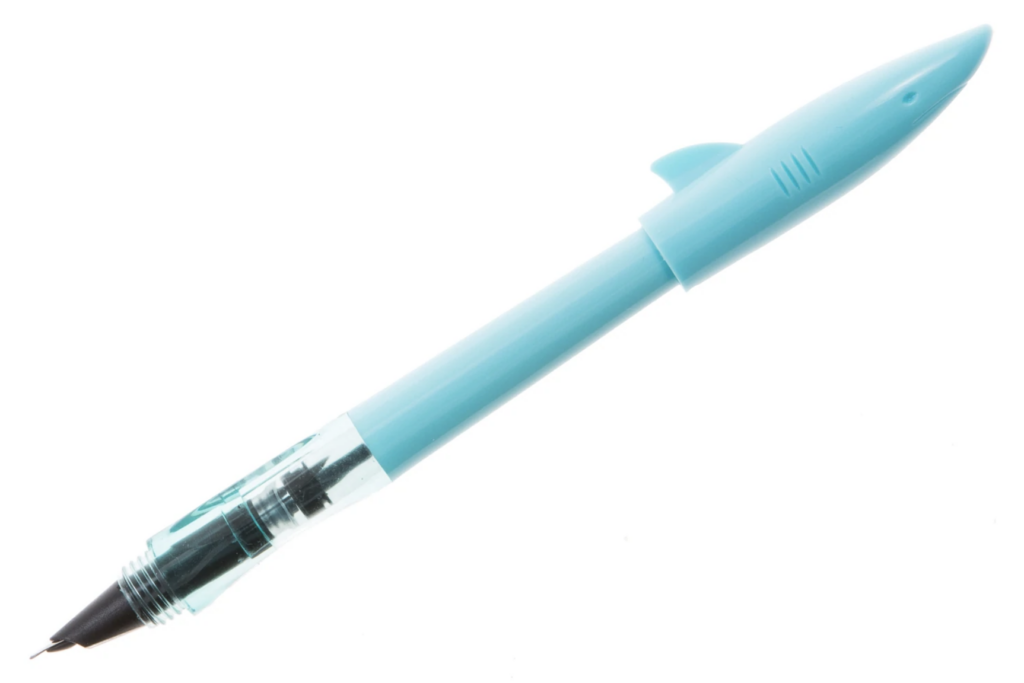
This is a fountain pen shaped like a shark. It costs less than four dollars. I have one and it is delightful. It writes far better than a pen that costs less than four collars has any right to write. I use it about as much (or more) than my fancy-pants Sailor 1911, which is really saying something.
Also: some of the colors are currently on sale for one dollar and ninety-seven cents.
ONE DOLLAR AND NINETY-SEVEN CENTS.
It should be illegal to sell something so functional and charming for so little money, but I’m glad it’s not.
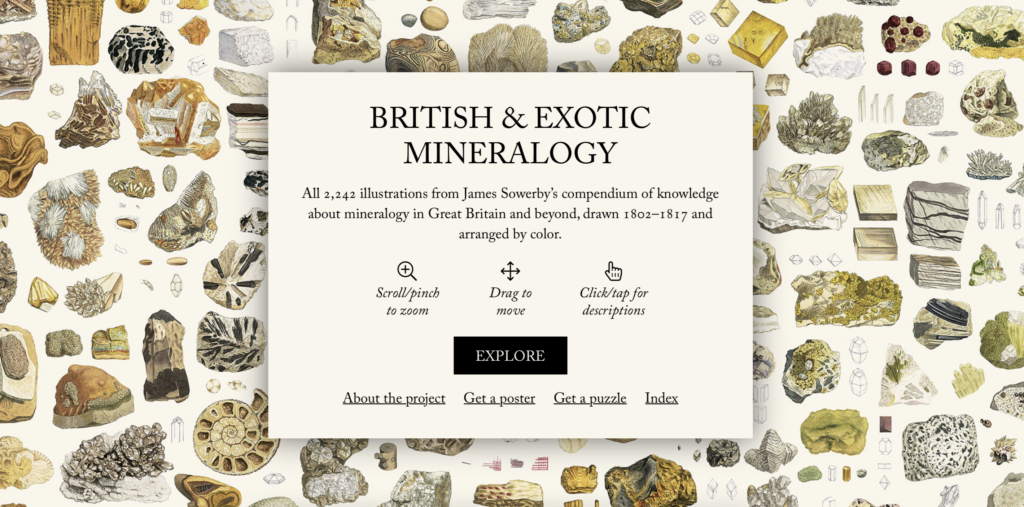
Interactive! Illustrated! Compendium!
…OF ROCKS!
This is one of those situations where the “About the Project” page contains just as many delightful surprises as the project itself. Just a treat from start to finish.
(Reminiscent of An Ocean of Books, a project I blogged about back in November of 2020.)

Again, Sarah Manguso:
My goal now is to forget it all so that I’m clean for death. Just the vaguest memory of love, of participation in the great unity.
What does it mean to be a steward of something or someone in decline?
In caregiving or hospice work (and ecological thinking in the era of climate collapse), this is clearly the game, but I catch myself wondering how it translates to making a comic or writing an essay or any other generative act. How is this season of my life a form of cross-training?
Often I think of creation as an additive process—raising a child, building a city, weaving a carrier bag. But what if, rather than moving closer to the realization of a vision, the putting-down-on-paper-ness of it all degrades the original, unthinkable idea? (However I pronounced “Hermione” in my head as an eight-year-old, for example, vanished the moment I listened to Harry Potter and the Philosopher’s Stone on audiobook.)
I say “degrades” and feel the jolt of negative connotation, but I don’t mean for this to be negative. There are many ways to think about caring for someone with less time left on this earth than I have. Some of them are negative, depressing, dispiriting. Some days I succumb to that helplessness. But there’s a richness to it, too, even if it doesn’t fit the cultural model we’ve inherited for worthwhile heroics. Again, Le Guin: “[…] the Hero does not look well in this bag.” I try to apply the grandiose posturing of meeting an impossible deadline to the work of caregiving and instead I come up against the fact of death again and again and again.
I think there’s still a part of me clinging to the idea that if I could only become [blugh] enough, I could bring my ideas into the world in a visual form that fully encapsulates what’s present in my mind. And yet: 100% of the time, the page I draw does not, cannot, match the one I envisioned when I sat down at the drawing board. And yet and YET: 100% of the time the physical manifestation of that vision eclipses what I’d imagined. Maybe not in the moment, because I’m stubborn and I’ll usually spend a day or two scowling at whatever’s ended up on the page, muttering about how I’m not mad I’m just disappointed, but once I’ve gone away and come back and seen the page contextualized in the greater stream of the narrative, it’s like someone’s shaken the Etch-a-Sketch. Blank slate. The vaguest memory of love.
New year, new Ramble.
This one (my 30th since I started this practice in June of 2019!) is about stuff I lost track of in 2021, things I’m thinking about in the new year, trying to abandon perfectionism, what to share and what not to share, the topography of the Ojai Valley, and various other things.
Also: looked at a bunny, found some owls.
You can read the transcript or browse all the notes and associated ephemera over on Patreon for free, or just listen directly below.
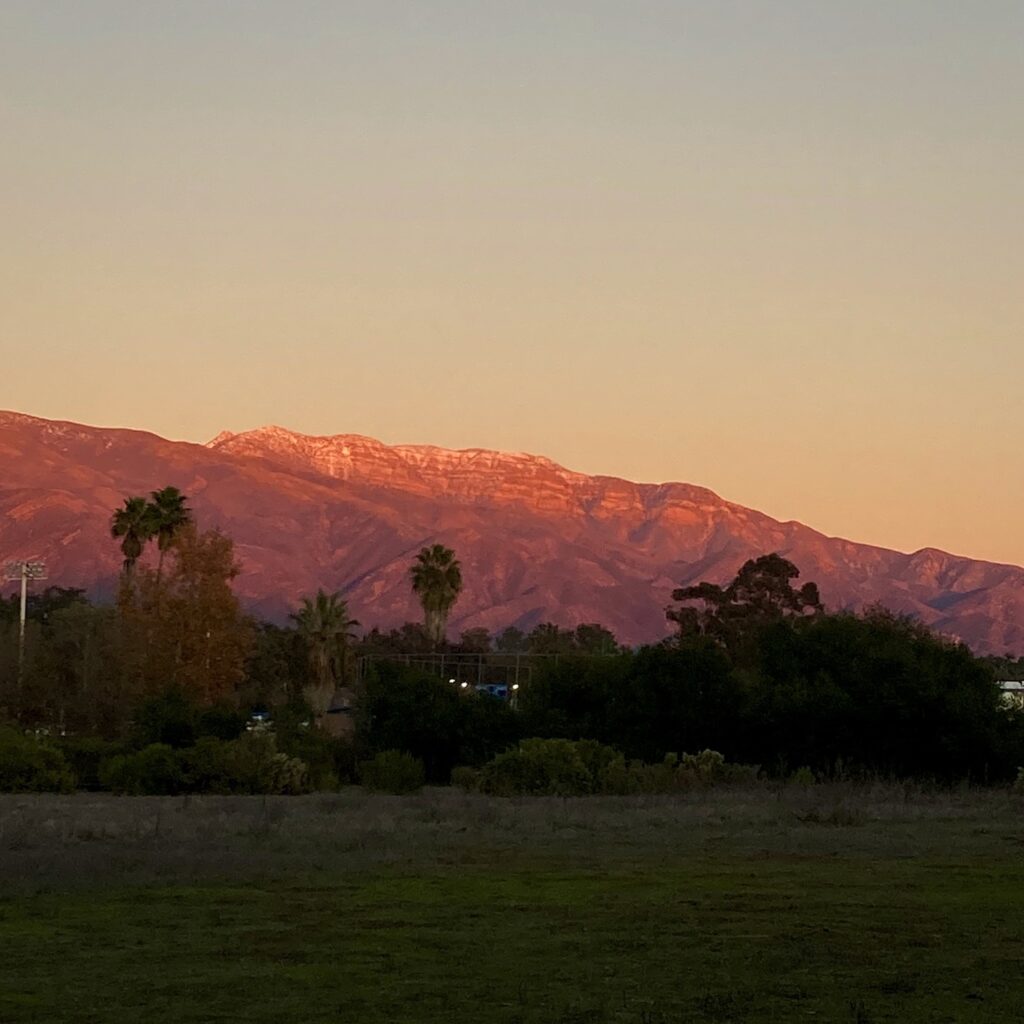
[Rambles are typically 20-minute freeform audio updates recorded outside every couple of weeks. You can listen to previous Rambles here or subscribe directly in the podcast app of your choosing with this link.]
Trying not to be precious about year-end stuff right now because I’m feeling stuck, but here’s a big list of things I read in 2021! Reading was hard this year for…well, you know. All the reasons. I needed a lot of comfort food to get through the upheaval of moving home, and for huge swaths of time I felt as if I’d lost access to the part of my brain that thrilled to Alberto Manguel or Le Guin in the first part of the year. I’m still sort of there.
Read a lot of comics (thanks, Danielle’s studio library and also The Actual Library) because I started drawing a graphic novel and it turns out reading more comics helps your brain think in comics??? Who knew. I still feel like I’m scratching my way towards figuring out what really makes a comic work for me. It takes a lot to get me excited about them, which feels somewhat icky as a person who knows first-hand how much fucking time they take. But there it is!
Started trying to track rough start/end dates towards the second half of the year because I got curious. I’ll probably stick with that into 2022.
Bubble and The Liar’s Dictionary both made me laugh out loud. The Creative Habit and Always Coming Home reminded me how I got to be the way I am. I’m sure there are other books I felt feelings about but I’m just going to HIT PUBLISH.
See previously: 2020’s Big List
| Legend | Rough Guide to Ratings |
|---|---|
| 🎭 – Plays 📝 – Poetry 📖 – Books (Fiction) 📓 – Books (Nonfiction) 💬 – Graphic Novels | ❤︎ = Yes ❤︎❤︎ = Oh Yes ❤︎❤︎❤︎ = Oh Hell Yes |
make note
make notes toward what you want to keep
noticing—let the notes, all the little bits of cumulative debris
(internal cumulus clouds), let these be
a kind of song, too
//
to live among & within & through words or more vitally, caring attention—that’s the daily practice, not writing poetry 24/7. but living with poetry brain, which could be the same, depending on the day, as laundry brain or long-talk-with-good-friend brain or soup brain
Chen Chen
Swoon.